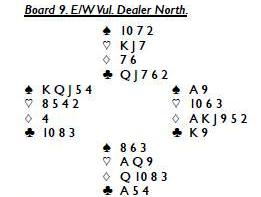The World Wide Bridge Contest is a long-standing tournament in the World Bridge Federation’s calendar, 2013 is its 27th year, and I do hope you all enjoyed this event and found the hands interesting and challenging – my thanks go to Eric Kokish for his excellent and most entertaining commentary. Gianarrigo Rona, President, World Bridge Federation.
E/W will have an unimpeded auction and will usually finish in 3NT after East shows his two suited hand and West shows a balanced minimum with only two hearts and no great love of clubs.
Inevitably, some will reach 4] when West admits to moderate support and East deems his hand more suitable for suit play. Although South can’t get in to cash a second club winner if declarer ducks one round of clubs, communication problems are simply too great for declarer to cash all his (11) winners once the ![]() A has been dislodged, assuming North switches to clubs if the suit hasn’t been led.
A has been dislodged, assuming North switches to clubs if the suit hasn’t been led.
It’s a really annoying hand for declarer, and the defense is not especially difficult, but if N/S permit declarer to untangle his winners, -450 or -460 will be horrible results.

Most of the Easts who open 1![]() plan to rebid 2
plan to rebid 2![]() (for which they would be maximum) or 3
(for which they would be maximum) or 3![]() (for which they would be minimum); style and upbringing will determine which sequence holds greater appeal. West will pass either of those rebids. The other 1
(for which they would be minimum); style and upbringing will determine which sequence holds greater appeal. West will pass either of those rebids. The other 1![]() openers, whose 1NT openings would be weak, plan to rebid 1NT (15-17), an accurate value bid portraying the balanced character of the hand. While West might pass a strong 1NT rebid, his hand may not be worth
openers, whose 1NT openings would be weak, plan to rebid 1NT (15-17), an accurate value bid portraying the balanced character of the hand. While West might pass a strong 1NT rebid, his hand may not be worth
much opposite a doubleton spade lacking the ace, so taking out to 2![]() or 2
or 2![]() will seem more attractive. East will pass 2
will seem more attractive. East will pass 2![]() but will use his judgment over 2
but will use his judgment over 2![]() , as West might well be five-five.
, as West might well be five-five.
Similar considerations might apply at the tables where East opens a strong notrump rather than 1![]() . West might simply sign off in 2
. West might simply sign off in 2![]() , usually via transfer, or instead use Stayman where his methods permit him to show a weak hand with both majors at his next turn, either by bidding 2
, usually via transfer, or instead use Stayman where his methods permit him to show a weak hand with both majors at his next turn, either by bidding 2![]() or (as more commonly played) 2
or (as more commonly played) 2![]() , inviting correction to 2
, inviting correction to 2![]() with longer or perhaps stronger spades.
with longer or perhaps stronger spades.
This time, the money contract is 2![]() which can produce eight tricks if declarer can establish West’s long heart without losing a trump promotion or losing control. In 2
which can produce eight tricks if declarer can establish West’s long heart without losing a trump promotion or losing control. In 2![]() , although the trumps (also) break three-three, the defenders
, although the trumps (also) break three-three, the defenders
should have time to arrange a fourth trump winner, either by South ruffing a fourth round of clubs high or by North ruffing a third round of diamonds high.
The poor lie of the trump suit will be a disappointment to the declarers in diamonds, but not if South leads a spade (the normal choice) rather than from one of his unattractive holdings in the other suits. On a spade lead declarer can
win with the ace, cash ace-king of diamonds, and guess to play three more rounds of spades. South ruffs the last with a trump winner and the defense gets only one more trump trick and three tricks in hearts and clubs combined: +90 in 2![]() , -100 in 3
, -100 in 3![]() .
.
If South leads the ![]() A he can still switch to hearts and hold diamond contracts to seven tricks, but a low club will allow eight tricks. Best for South is a high heart, followed by a timely club switch from North after winning the second or third round of hearts, but if West declares, North will probably lead clubs so the defense will be well on its way to taking all seven of its tricks.
A he can still switch to hearts and hold diamond contracts to seven tricks, but a low club will allow eight tricks. Best for South is a high heart, followed by a timely club switch from North after winning the second or third round of hearts, but if West declares, North will probably lead clubs so the defense will be well on its way to taking all seven of its tricks.
A few West players will correct 2![]() to 2
to 2![]() , especially in systems where (a) this doesn’t show much, and (b) East might have five diamonds and as many as three spades. That will work beautifully this time if East does not raise to 3
, especially in systems where (a) this doesn’t show much, and (b) East might have five diamonds and as many as three spades. That will work beautifully this time if East does not raise to 3![]() , expecting longer spades and often a better hand.
, expecting longer spades and often a better hand.
